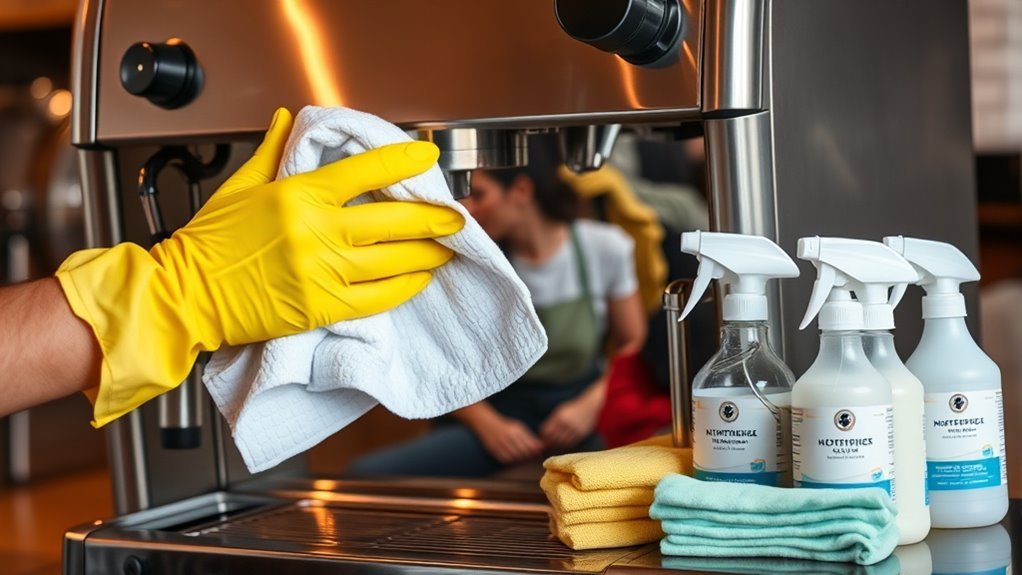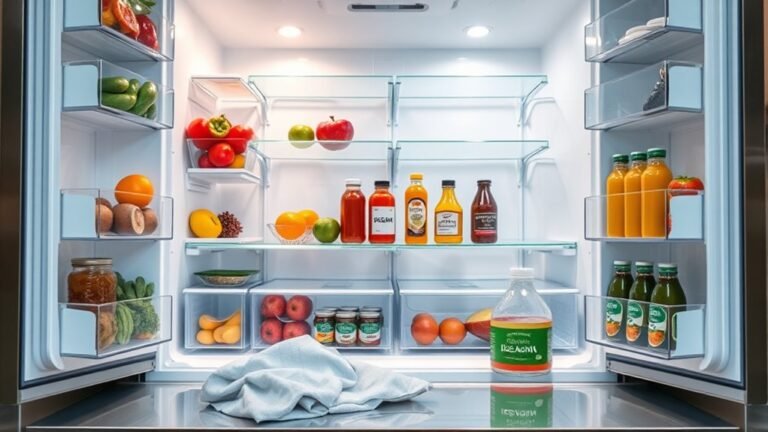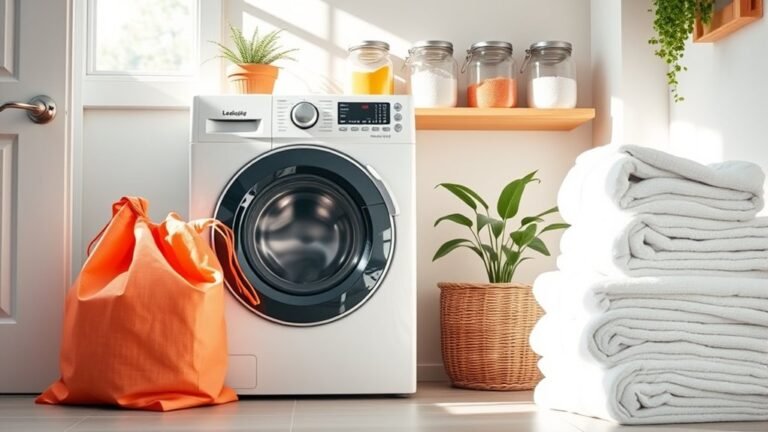Disinfecting High-Touch Areas in Coffee Machine
You should regularly disinfect high-touch areas on your coffee machine—like buttons, levers, handles, and the water reservoir lid—to keep it hygienic and guarantee fresh, great-tasting coffee. Use a soft microfiber cloth with a safe disinfectant, and clean hard-to-reach spots with cotton swabs. Cleaning after use and weekly disinfecting will prevent bacteria buildup and extend your machine’s lifespan. Keep your coffee station spotless, and you’ll enjoy every cup even more. There’s plenty to know about proper techniques and timing to keep it in top shape.
Importance of Cleaning Coffee Machine Surfaces

Although it might seem like a small task, cleaning your coffee machine surfaces is essential for maintaining both hygiene and the quality of your brew. You want to enjoy your coffee without worrying about bacteria or residue affecting the taste. Sticking to a regular cleaning frequency guarantees your machine stays fresh and safe for every use. Good hygiene practices don’t just protect your health—they also keep your equipment running smoothly, saving you time and money in the long run. By making surface cleaning part of your routine, you reclaim control over your coffee experience and embrace the freedom to savor every cup without compromise. Remember, a clean machine means a better brew and a healthier you.
Identifying High-Touch Areas on Your Coffee Machine
Keeping your coffee machine’s surfaces clean sets the stage for a better brew, but knowing which spots to focus on can make your efforts even more effective. To identify high-touch areas, observe your user habits closely. Touch points like buttons, levers, the steam wand, and the handle where you open the machine are prime spots for germs to gather. Don’t forget the water reservoir lid and drip tray—these get frequent contact too. Your personal routine influences which parts you touch most, so tailor your cleaning to those areas. By zeroing in on these key touch points, you’re not just cleaning—you’re protecting your freedom to enjoy coffee safely without unnecessary fuss or contamination.
Recommended Cleaning Supplies for Disinfection

To disinfect your coffee machine effectively, you’ll need a few essential cleaning supplies. First, consider eco friendly alternatives like vinegar, baking soda, or hydrogen peroxide, which offer powerful cleaning without harsh chemicals, letting you maintain your freedom from toxins. If you prefer speed and convenience, commercial cleaning solutions designed specifically for coffee machines are reliable options, ensuring thorough disinfection of high-touch areas. You’ll also want soft microfiber cloths or disposable wipes to avoid scratching surfaces. Gloves protect your hands during cleaning, and a small brush helps reach tight spots. By choosing the right supplies, you can confidently keep your coffee machine clean and safe without compromising your values or freedom.
Step-by-Step Guide to Disinfecting Buttons and Controls
Once you have your cleaning supplies ready, it’s time to focus on the buttons and controls, which often harbor germs from frequent use. Start by turning off the machine and unplugging it for safety. Lightly dampen a microfiber cloth with a disinfectant approved for electronics—avoid soaking to prevent damage. Gently wipe each button and control surface, paying special attention to crevices where dirt and bacteria collect. Use cotton swabs for hard-to-reach spots. Follow the best practices by allowing the disinfectant to air dry completely before plugging the machine back in. To maintain hygiene and your freedom from illness, incorporate this process into your regular cleaning schedule, ideally daily or after heavy use. Consistent care guarantees your coffee machine stays safe and ready for your next brew.
Proper Cleaning Techniques for Handles and Levers

Handles and levers are touched frequently, making them prime spots for germs and buildup. To keep your coffee machine fresh and safe, you’ll want to clean these parts regularly, adjusting the cleaning frequency based on how often you use the machine. Different handle materials, like stainless steel, plastic, or wood, require specific care. For stainless steel and plastic, a mild detergent with warm water works well, followed by wiping with a disinfectant safe for those surfaces. If you’ve got wooden handles, avoid soaking them; instead, use a damp cloth with a gentle cleaner to protect the material. Always dry handles thoroughly to prevent moisture damage. By adopting these straightforward cleaning techniques, you maintain both hygiene and the integrity of your coffee machine’s handles and levers.
Sanitizing the Coffee Spout and Drip Tray
Every coffee machine has at least two key areas that need regular sanitizing: the coffee spout and the drip tray. You want these spots clean to keep your brew fresh and your hands safe. Start by:
- Wiping the coffee spout with a damp cloth soaked in a mild disinfectant to remove coffee oils and germs.
- Removing the drip tray and washing it thoroughly with warm, soapy water, then rinsing and drying it completely.
- Using a small brush or toothpick to clean crevices in both the coffee spout and drip tray, where residue and bacteria love to hide.
Frequency of Disinfecting High-Touch Areas
Keeping the coffee spout and drip tray clean is a great start, but knowing how often to disinfect these high-touch areas makes all the difference. Sticking to a solid disinfection schedule lets you enjoy your coffee without worry. Frequency guidelines depend on usage and environment, but regular care keeps germs at bay and your freedom intact.
| Area | Recommended Frequency |
|---|---|
| Coffee Spout | After every use |
| Drip Tray | Daily |
| Buttons/Controls | Weekly |
| Water Reservoir Lid | Weekly |
| Exterior Surfaces | Weekly |
Follow this schedule to keep your machine fresh and yourself free from contamination. Staying consistent with these frequency guidelines guarantees a safer, better coffee experience every time.
Avoiding Damage While Cleaning Your Coffee Machine
To keep your coffee machine in top shape, you’ll want to choose safe cleaning products that won’t harm its components. Using proper cleaning techniques is just as important to avoid damage while disinfecting. Let’s look at how you can clean effectively without risking your machine’s performance.
Safe Cleaning Products
Someone might think any cleaner will do when disinfecting your coffee machine, but that’s not the case. Choosing safe cleaning products guarantees you protect both your machine and your freedom from harsh chemicals. Here are three essentials to keep in mind:
- Opt for eco friendly options like vinegar or baking soda solutions—they’re effective without risking chemical damage.
- Avoid bleach or ammonia-based cleaners that can corrode sensitive parts and linger as harmful residues.
- Look for products labeled with chemical safety certifications to assure they’re gentle yet powerful enough for disinfection.
Proper Cleaning Techniques
Although disinfecting your coffee machine is essential, you’ll want to use techniques that prevent damage to its delicate components. Start by following a regular cleaning frequency—ideally after every use for removable parts and weekly for the entire machine. Use gentle disinfection methods like diluted vinegar or mild soap solutions, avoiding harsh chemicals that can corrode surfaces or affect taste. Always unplug the machine before cleaning and never submerge electrical parts in water. Use soft cloths or brushes to reach high-touch areas without scratching. Rinse thoroughly to remove any residue, and let parts dry completely before reassembling. By balancing effective disinfection methods with careful handling, you’ll keep your coffee machine both clean and functional, giving you the freedom to enjoy fresh brews without worry.
Tips for Maintaining a Hygienic Coffee Station
Keeping your coffee station hygienic starts with simple daily habits that prevent buildup and contamination. You want to enjoy your coffee freely, without worrying about germs or sticky surfaces. Here are three hygiene practices to keep your space fresh and inviting:
- Wipe down all surfaces, including counters, handles, and drip trays, with a disinfectant wipe daily.
- Empty and clean the coffee grounds container regularly to avoid mold and odors.
- Store coffee beans and filters in airtight containers to keep them fresh and free from dust or pests.
Impact of Regular Disinfection on Coffee Taste and Safety
When you regularly disinfect your coffee machine, you not only reduce the risk of harmful bacteria but also preserve the pure flavor of your brew. Keeping your machine clean guarantees that every cup tastes fresh and vibrant, free from lingering residues that dull coffee flavor. Plus, the health benefits are clear: a sanitized machine means fewer germs and a safer experience. This simple habit empowers you to enjoy freedom from worries about contamination.
| Benefit | Impact on Coffee Flavor | Impact on Health |
|---|---|---|
| Reduced bacteria | Maintains freshness | Lowers illness risk |
| Removes old residues | Enhances taste clarity | Prevents mold growth |
| Prevents blockages | Consistent flavor | Protects immune health |
| Prolongs machine life | Preserves aroma | Promotes hygiene |
| Saves money | Enjoyment every cup | Supports well-being |
Frequently Asked Questions
Can I Use Vinegar to Disinfect My Coffee Machine?
Imagine vinegar as a wise guardian, clearing away shadows of grime with its natural power. You can use it to clean your coffee machine, enjoying vinegar benefits like cutting through mineral build-up and bacteria. However, it’s not a full disinfectant against all germs, so don’t rely solely on it. To keep your freedom from sticky residues and unwanted flavors, clean your machine regularly—aim for a cleaning frequency of once a month to stay fresh and free.
Is It Safe to Use Bleach on Coffee Machine Parts?
You shouldn’t use bleach on coffee machine parts because bleach safety is a big concern—it can damage your machine and leave harmful residues. Instead, stick to coffee machine maintenance methods recommended by manufacturers, like using vinegar or specialized cleaners. This way, you keep your machine in good shape without risking your health. You want freedom to enjoy your brew, so play it safe and avoid bleach to preserve both your machine and your peace of mind.
How Long Should Disinfectant Sit on Surfaces Before Wiping?
You’ll want to let the disinfectant sit on surfaces long enough to maximize disinfectant effectiveness, usually between 1 to 10 minutes depending on the product instructions. Different surface types might require different contact times—porous ones often need longer. Don’t rush wiping it off; letting it dwell guarantees germs are truly killed. Just follow the label, and you’ll keep your space safe while still enjoying the freedom to live your way.
Can Disinfecting Affect the Machine’s Warranty?
Did you know over 60% of warranty claims get denied due to improper care? When it comes to your coffee machine, using harsh disinfectant types not approved in your warranty terms can void it. You want freedom to keep things clean but sticking to manufacturer guidelines is key. Always check which disinfectants are safe to avoid losing warranty protection while keeping your machine spotless and worry-free.
Are There Eco-Friendly Disinfectants Safe for Coffee Machines?
You’ll find plenty of plant-based options that are gentle yet effective, letting you keep things fresh without harsh chemicals. Natural cleaners made from ingredients like vinegar or essential oils work well and won’t damage your coffee machine. These eco-friendly disinfectants give you the freedom to stay green while protecting your gear. Just make sure to check compatibility with your machine’s materials to keep everything running smoothly.






